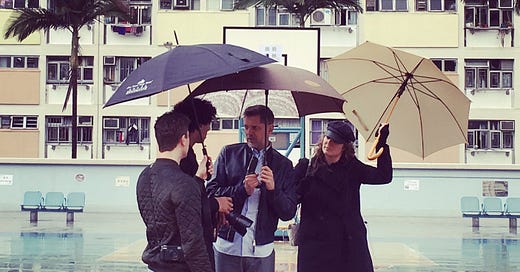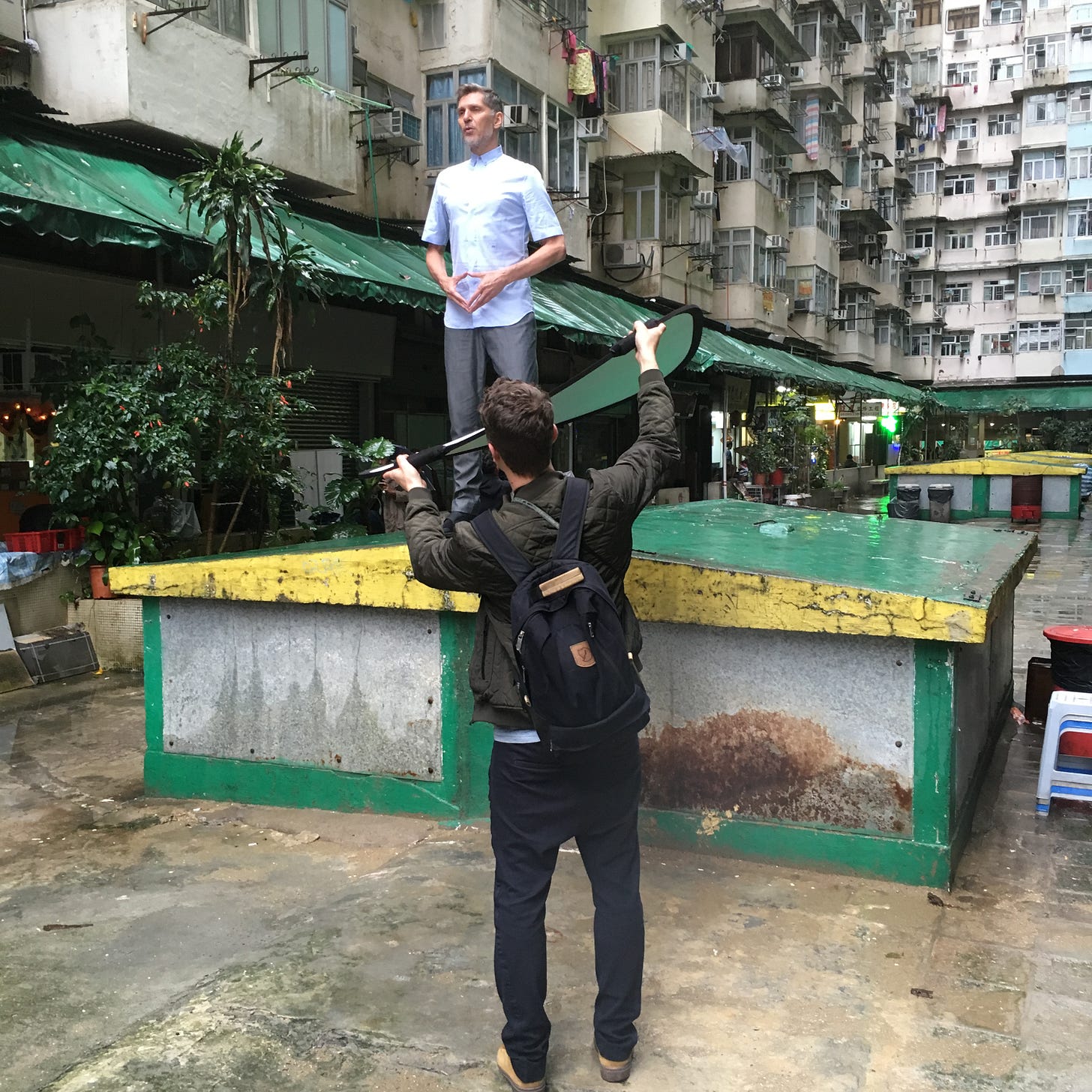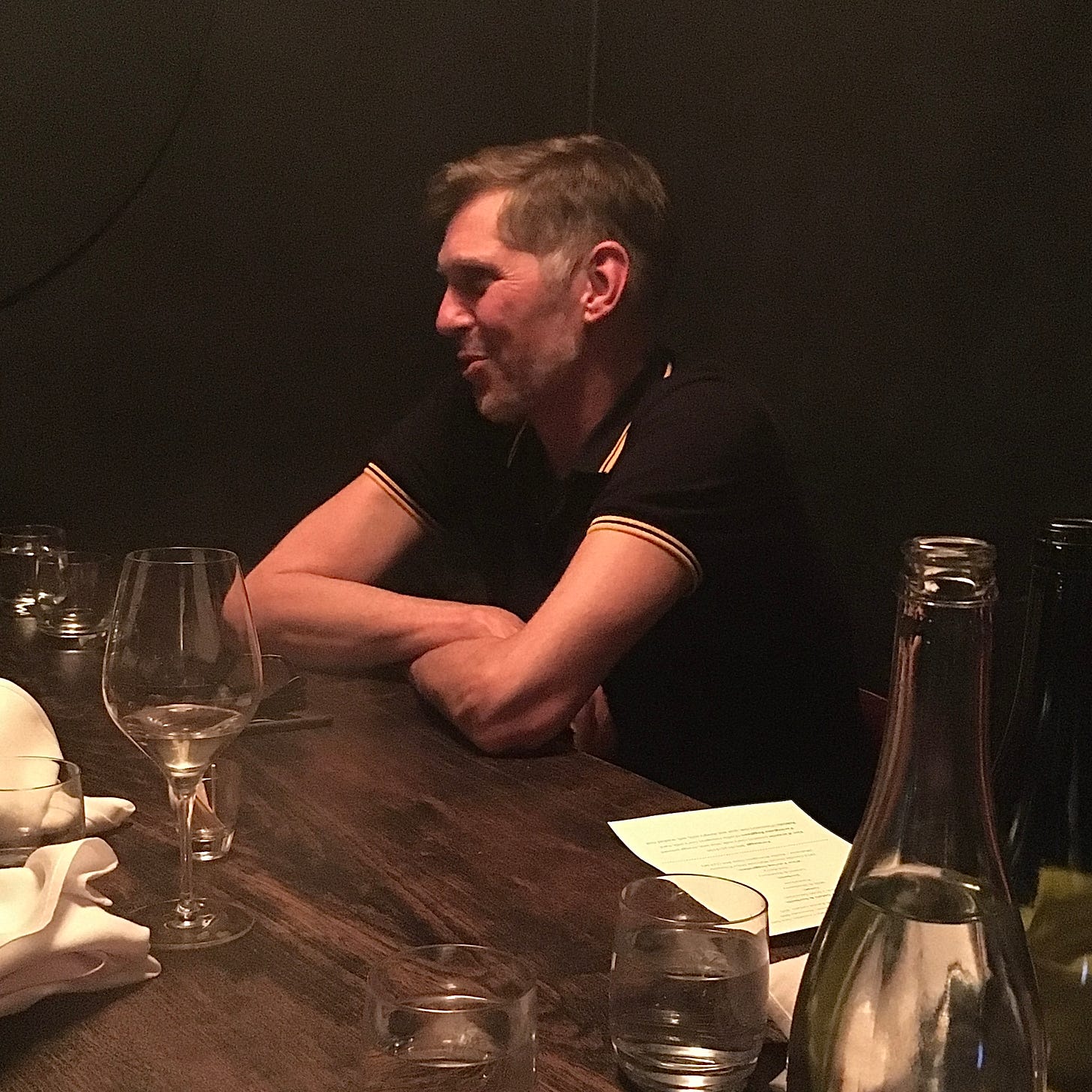Erwin Olaf: 'I wanted to show everyone so badly what I was capable of. Look at me! Look at me!’
In 2016 I traveled to Hong Kong to interview photographer Erwin Olaf for Holland Herald. There was much rain, even more laughter, but also the grim reality: 'This is where my grief is coming from.'
Rain. Relentless, pounding rain. You might become miserable if you had to work in this weather all day, but the rain in exotic Hong Kong is always better than the rain at home. And working with Erwin Olaf (57) means you don’t get a chance to be cranky. His anecdotes, accompanied by his bellowing laugh, never end. From the moment he gets into the ramshackle van that drives us from location to location (‘We saw Leonardo DiCaprio last night!’ What was he like? [Laughter] ‘Bloated!’) until we almost fall off our chairs at jazz café Peel Fresco, from fatigue, laughter and, quite possibly, white wine.
Olaf is in Hong Kong at the invitation of the Ruinart champagne house. He’s working on a photo project featuring them, which is being made especially for an exhibition booth at the ArtBasel art fair. Olaf also has a solo exhibition in Hong Kong, at Gallery Art Statements. His work is doing well, very well indeed. A few days ago, he was in Moscow, where he was welcomed like a rock star. Before that, he was in Paris, and after Hong Kong, he’s off to Kyoto and New York: ‘I’m living in a wonderful bubble!’
He seems to be embarking on a second career wave. Not that he’s ever known a bad period since he started in 1984. He has, he says, sold more work each consecutive year.
However, a change has taken place. Initially, he was known as the ‘shock photographer’, with his provocative, almost aggressive imagery; baroque nudes, plus-size women and bondage. But he entered a new territory with the triptych Rain (2004), Hope (2005) and Grief (2007), whispering instead of shouting, and exploring new themes such as loneliness, frailty and sorrow. Since then, he has experienced one highlight after another: the Johannes Vermeer Award (the Dutch State award for the arts with a €100,000 prize), a portrait series with Dutch Queen Máxima, a new euro coin with the portrait of King Willem-Alexander, and the Catwalk costume exhibition he curated for the Amsterdam Riiksmuseum this spring.
Reality is boring
If he had been a little more courageous as a teenager, we would never have heard of Erwin Olaf the photographer. ‘I really wanted to be an actor. In elementary school, I would put plays together. On stage, I pretended to emerge from a bath naked. Discreetly behind a towel, of course!’ The penchant for provocation was there from an early age.
He wanted to go to drama school, but didn’t dare tell the headmaster (‘a nasty macho gym teacher’). ‘He told me: You can write very well, here’s a brochure about the School of Journalism.’ Eureka! Not that Olaf suddenly discovered a passion for writing. ‘The leaflet stated that the school would want you to live away from home, and detach yourself from your parental environment. That’s what I wanted, to get away from rural Holland!’
Student life was one big party. ‘I recognized feelings I had always had in nightlife. The people I met weren’t always the most beautiful, but they looked great and managed to turn their disadvantages into advantages.’ He entered into a dream world, with theatrical misfits and other colourful characters. ‘Life wasn’t just one big party then, though. It might sound a bit prissy, but living alone can make you feel quite unhappy. I often went to the cinema; films were my great escape. The things I saw then still exert a great deal of influence on my work - films by directors Luchino Visconti and Federico Fellini, The Man Who Fell to Earth with singer David Bowie, and Douglas Sirk's 19505 tearjerker movies, which were so beautifully staged.’
At school, someone pressed a camera into his hands. ‘From the moment I held that camera, developed my first film and made my first print, I was hooked. This was my world.’
He started photographing all the parties he went to. ‘But real life is boring. In the studio, I discovered that I could shape reality. That’s where I could let my imagination run wild.’ The party people he met were his first models. ‘They were so unreserved, which inspired me, and they also gave me ideas. I heard about a girl who could lift 150kg. I thought: That means she can lift a man over her head. I called her and asked her to do so. She agreed, but she only wanted to do it naked. That became my first nude photo.’
Done kicking
‘Like riding a wave’ is how Olaf considers himself and his career. ‘I started in the 1980s, when unemployment was high and photography was slowly becoming recognized as an art form. Magazines flew off the shelves; I could get really creative, page after page.' In the 1990s, the advertising market exploded, resulting in major assignments. Olaf created the high-profile Dirty Denim campaign for denim brand Diesel, photographing octogenarians in jeans. He won a Silver Lion award at the Cannes advertising festival for it, and Diesel became advertiser of the year. ‘Well guys, after that, the phone didn’t stop ringing!’
Olaf could easily have continued his commercial work and success for years. But then he got a wake-up call from his redhead intern Shirley den Hartog in 1998. ‘I asked her to be my manager because I felt submerged in all my work. She said: I’ll do it, but only if you will make your own, autonomous work again.’ Their cooperation has turned out to be a winning combination. ‘Shirley is the brains, I am the balls.’
Their first series together was Mature, which portrayed elderly women as pin-ups. And Royal Blood (2000), including a battered Princess Diana lookalike, was a huge success. ‘This series simply had to be made, it was very heartfelt for me. I wanted to talk about the beauty of youth and our fascination with violence, and I was eager to do something with that brilliant invention Photoshop, allowing me to indulge in my fantasies.’
Then came the second wake-up call. ‘I was invited to show my portfolio at the Getty Museum in Los Angeles. When the curator got to Royal Blood, she said: ‘And now I’m going to say something you are going to remember for the rest of your life: we call this Eurotrash.’ That brought me back down to earth. In France, Italy, Spain and Russia, I was considered a hero. But it was good that someone told me to stop my one-way onslaught. Because that was what I was really doing: shocking people, attracting attention. Aesthetically great, but how much depth is in there? Indeed, I have always remembered that comment. It really got to me. Royal Blood became the end of a cycle. How long can you keep kicking against the establishment? I’d done enough kicking.’
Time travel
Olaf is primarily a photographer for his own enjoyment. ‘It’s almost like therapy.’ In 2012, he published Own, an overview of his work from 1984 until 2012. ‘When I held the first copy, I thought: This is my diary. You can see exactly what mood I was in for each series: aggressive, ambitious, exploring sexuality. I am very proud of the period after 2000, with Royal Blood as the conclusion of my expressive phase. I’ve grown and I’m happy to see that I’m still developing, as a photographer but also as a human being. I made a number of bad photos between 1992 and 2000. I was so unhappy and angry then. I thought the whole world was supposed to be at my feet, but I was ignored for the first time in my career, when strong female photographers were appearing, like Inez van Lamsweerde and Rineke Dijkstra. I wanted to show everyone so badly what I was capable of. Look at me! Look at me!’
Things began to change slowly from 2003 onwards. ‘I was having a laugh with a group of models, depicting a dance studio and suddenly thought: This doesn't look real. I asked a boy and a girl to move to separate sides, wanted them to stand still, and suddenly there was this tension. A story had arisen that was open to interpretation; something the viewer could fill in, rather than having me one-dimensionally pushing my message through.’ The resulting series Rain and Hope were intriguing, full of stillness and austerity, with nostalgic styling inspired by the American 1950s. Time travel, he calls it. ‘I also wanted to travel in emotion, though. Grief was ultimately a very important series, because I feel it completely represented me. It is based on my first clear memory in 1964, when I was five years old. It felt as if everyone and everything in the world had become silent, which was the impact of American president John F. Kenned's death. That was the premise of Grief, encompassing those first tears that well up when one realizes: “My husband isn't coming back”, or “My child is deceased”. It involves violent stories, with the deepest emotions I did not know could exist.’
What was he himself mourning? ‘I still sometimes wonder. Maybe, the end of my 23-year-long relationship, even though that was already a few years ago at the time. Or, perhaps, my chronic disease, which I was becoming increasingly aware of. In 1996, I heard that I have hereditary emphysema; the older I get, the more my condition deteriorates. The advantage is the fact that I have to seize the day, but I really had to learn to deal with it. That process began with Grief. And when I turned 50, I made three self-portraits, one with an oxygen tube in my nose, based on what my future will look like. That made it clear: that's where my grief was coming from.’
Peace of mind
The trip to Hong Kong is actually not so easy for him. ‘I travel a lot, which my lung specialist strongly advises against, but I have to do this now, for my career. I also enjoy it, though. Fortunately, my partner is flexible and very fond of travelling, and it’s so great to see things through someone else’s eyes. I've been here six times, but Kevin’s enthusiasm makes me realize what a lovely city this actually is. People are so open and interested, and you can have a great meal anywhere. If it’s raining, as it is now, you can visit the indoor shopping malls, and look at all the things you can’t afford.’
For work, Olaf mainly travels to cities, but personally he likes spending time in nature, for example in Sri Lanka, Panama and Thailand. ‘Birds, butterflies, the sound of the sea, the noise of cicadas... Sitting on my secret island, while I hear the grasshoppers chirping away, I couldn’t be any happier. Photography has taken me all over the world. I could never have imagined that when I started out, still on unemployment benefits. I have had such a blessed life, and it’s still great. But my big statements have already been made, and that gives me peace of mind. Everything else that might happen is a bonus.’
In 2019, when he turns 60, Olaf will have a major retrospective in The Hague. In the same year, he hopes to release his first feature film, based on a novel by Arthur Japin. ‘I just read the latest draft of the script during my flight from Moscow, and tears welled up in my eyes twice. I always get wonderfully sentimental on airplanes, but there are some really beautiful images in the script. Like Visconti meets Fellini, the two people who have influenced my work the most. It’s called Een schitterend gebrek (A brilliant defect). That's actually been a major theme in my life since hanging out with the beautiful party people from my student days. Everything comes together in this film.’
‘I feel significantly happier now than I did ten or 15 years ago. Less ambitious. Though I still enjoy playing the game, strolling around at ArtBasel, I also like to go home and sit on the couch, watching House of Cards and Downton Abbey with Kevin. [Laughs out loud] ‘That beats being world-famous.’
This interview was previously published in Holland Herald, July 2016
I made the snapshots below during the day we were racing through Hong Kong in the pouring rain for the photo shoot. The Holland Herald team: Mounir Raji (photography), Sandra de Cocq (production), Linda Gumus Gerritsen (styling), Bram Spaan (assistant photography)







